Edward Durell Stone
| Edward Durell Stone | |
|---|---|
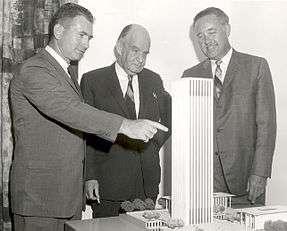 Stone (center) viewing a model of NASA's Electronics Research Center, 1964 | |
| Born |
March 9, 1902 Fayetteville, Arkansas, United States |
| Died |
August 6, 1978 (aged 76) New York City, New York, United States |
| Nationality | American |
| Alma mater | University of Arkansas, Boston Architectural College, Harvard University, MIT |
| Occupation | Architect |
| Buildings | Radio City Music Hall, Museum of Modern Art, Kennedy Center, 2 Columbus Circle, First Canadian Place, Aon Center, University at Albany Uptown Campus |
Edward Durell Stone (March 9, 1902 – August 6, 1978) was a twentieth century American architect. An early proponent of modern architecture in the United States, he designed buildings throughout the world. Stone’s notable works include Radio City Music Hall and the Museum of Modern Art, both in New York City, the United States Embassy in New Delhi, India, and the John F. Kennedy Center for the Performing Arts in Washington, D.C.
Early life and education
.jpg)
Stone was born and raised in Fayetteville, Arkansas. His family, early settlers of the area, were prosperous merchants. He entered the University of Arkansas in 1920, but left after two years and moved to Boston to pursue a career in architecture. He studied at the Boston Architectural Club (now Boston Architectural College), and later attended Harvard University and MIT, but did not earn a degree. Though his interest was in modernism, Stone’s education was rooted in Beaux-Arts architecture. In 1927 he won the Rotch Travelling Fellowship (now called the Rotch Travelling Scholarship), which afforded him the opportunity to travel throughout Europe on a two-year stipend. He chronicled his travels in sketchbooks and watercolors in the fashion of a Beaux-Arts student. While in Europe he visited works by some of the foremost modernist architects of the period.[1] Many of these buildings would later be featured in the 1932 International Style exhibit at the Museum of Modern Art. The International Style would influence Stone’s early practice.
Practice
Stone returned to the United States in October 1929 and took up residence in Manhattan. Hired by the firm of Schultze and Weaver, his first job was designing interiors for the new Waldorf-Astoria Hotel. He subsequently worked for the Associated Architects of Rockefeller Center and became the principal designer of Radio City Music Hall. His first independent commission was the Richard H. Mandel House in Mount Kisco, New York (1933), a volumetric design with elements suggestive of the European modernists Willem Dudok and Le Corbusier. The success of the Mandel house, and other prominent early commissions, led to Stone’s appointment as associate architect for the Museum of Modern Art in New York City (1937), designed in collaboration with Philip Goodwin. Stone also designed a private residence for MoMA president Anson Conger Goodyear in Old Westbury, NY (1938). The Goodyear house incorporated floor-to-ceiling glass walls and a flat roof supported on thin metal columns in the manner of Ludwig Mies van der Rohe. The Mandel and Goodyear residences are both listed on the National Register of Historic Places.
Stone’s enthusiasm for the International Style had waned by the 1940s as he found new inspiration in American vernacular architecture and the work of Frank Lloyd Wright. At the outbreak of World War II, Stone closed his practice and enlisted in the U.S. Army. Promoted to the rank of major, he became chief of the Army Air Force Planning and Design Section and supervised the design of major airfields across the United States. Following his honorable discharge from the Army, Stone reopened his architectural office in New York City. His postwar houses continued to explore Wrightian motifs, rustic materiality, and modular design.
The scope of Stone’s practice expanded in the late 1940s. His ten-story El Panama Hotel in Panama City, Panama (1946), was oriented to the prevailing trade winds and employed open, single-loaded breezeways so that guest rooms could be cooled by natural ventilation instead of air conditioning. The University of Arkansas Fine Arts Center in Fayetteville (1948) won praise for its deft handling of a complicated program as well as for the excellence of the facilities it provided. Stone served as associate architect for major health care centers such as the University of Arkansas Medical Center in Little Rock, AR (1950) and the Hospital del Seguro Social del Empleado in Lima, Peru (1950). Hospitals that emphasized a humane environment by opening patient rooms to landscaped courts and gardens became a specialty of the Stone office.[2]
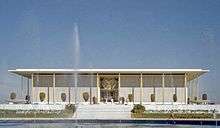
The Embassy of the United States in New Delhi, India (1954) would be Stone’s signature work; a building that fused the formalism of his Beaux-Arts training with a romantic historicism. Set on a podium, the elegantly detailed embassy resembled a temple, yet it was a sophisticated and environmentally-sensitive structure that employed passive solar controls and natural ventilation to reduce air conditioning loads. At the core of the building was a shaded atrium with a large reflecting pool and fountains. For additional shade and security, Stone enclosed the embassy in a two-story pierced grille of patterned terrazzo blocks that were cast on site. Stone’s embassy was widely praised; Frank Lloyd Wright called it one of the most beautiful buildings he had ever seen.[3] The embassy won a first honor award from the American Institute of Architects.
The New Delhi Embassy was a radical departure from the mainstream of modern architecture, and influenced the development of an architectural style that came to be known as New Formalism.[4] Stone established himself as one of the leading formalists with a series of extensively published buildings such as the Stanford University Medical Center in Palo Alto, CA (1955), the Stuart Pharmaceutical Company in Pasadena, CA (1956), and the United States pavilion at the 1958 Brussels World’s Fair (1957). In 1958 Stone was elected to the College of Fellows of the American Institute of Architects. He was also the subject of a Time magazine cover story.[5] His office began to receive larger and more prestigious commissions, entering a period of rapid expansion.
Guided by a comprehensive knowledge of architectural history, Stone sought to achieve a sense of permanence in his buildings. “I think of architecture as an enduring art," he said. "I am fond of saying that architecture should not attempt to be what is currently fashionable....It should not be influenced by transitory mannerisms. This is what I strive for. I try to do buildings that I think will endure and not be dated.”[6] By the mid-1960s Stone’s firm was among the largest architectural practices in the United States, with over 200 employees and offices on both coasts.[7] His clients included cultural, educational, and religious institutions, government agencies, as well as major corporations. Significant buildings from this period include the North Carolina State Legislative Building in Raleigh (1960), the Pakistan Institute of Nuclear Science and Technology in Nilore (1961), the National Geographic Society building in Washington, D.C. (1961), the Museo de Arte in Ponce, Puerto Rico (1961), the Albany campus of the State University of New York (1962), the John F. Kennedy Center for the Performing Arts in Washington, D.C. (1962), the General Motors building in New York City (1964), and the PepsiCo World Headquarters, in Purchase, NY (1967).
Stone continued to receive important commissions in the early 1970s, such as the Florida State Capital complex in Tallahassee (1970) and the Standard Oil building in Chicago (1970). The latter building, now known as the Aon Center, was among the tallest structures in the world at the time of its completion. Failing health forced Stone to retire from active practice in 1974. He died in New York City in 1978. Following a New York City funeral, Stone was buried in Fayetteville. His firm, Edward Durell Stone & Associates, continued to exist in various forms until 1993.
Educational work
In addition to his architectural practice, Stone was also devoted to the education of young architects. "The teacher," he said, "should not do the student's work. He should take the student's own conception, encourage him to do his own thinking, but suggest problems that might develop or ways in which the details can be improved. I try to help the student see the possibilities, to help open his eyes to the end of his project."[8] Stone taught at New York University’s School of Architecture and Applied Arts beginning in 1937, and later became the chief design critic and an associate professor of architecture at Yale’s School of Architecture. He served as a lecturer and visiting critic at other institutions, including the American Academy in Rome, Cornell, Princeton, and Stanford, until the demands of his architectural practice made it impossible for him to do so. He actively supported the establishment of an architectural program at the University of Arkansas. Stone’s work as an educator gave him the opportunity to recruit many skilled young staff members for his office. He also formed bonds with other prominent academics such as Walter Gropius at Harvard, Pietro Belluschi at MIT, George Howe at Yale, and William Wurster at the University of California, Berkeley. Stone's role as an educator was recognized in 1955, when the New York Chapter of the American Institute of Architects awarded him its Medal of Honor, praising Stone as a "distinguished designer of buildings and inspiring teacher.”[9]
Personal life
Stone married Sarah Orlean Vandiver in 1930; they had two sons. After his first marriage ended in divorce, Stone wedded journalist Maria Elena Torch in 1954. He and Maria had a son and a daughter before divorcing in 1966. In 1972 Stone married his personal assistant, Violet Campbell Moffat. They had a daughter and were still married at the time of Stone’s death in 1978.
His eldest son, the late Edward Durell Stone, Jr., was the founder and chairman of EDSA, a planning, landscape architecture and urban design firm based in Fort Lauderdale, Florida.
Reputation

Stone’s early embrace of the International Style placed him in the vanguard of his profession. Though his buildings were not considered to be pure examples of the style, his work was regularly published in professional journals as well as popular magazines. His buildings continued to be published after he abandoned the International Style in the 1940s, and publication would increase when he embraced New Formalism in the 1950s. His second wife, Maria, made use of her background in journalism to publicize and promote her husband’s career. At her urging, Stone published his memoir, The Evolution of an Architect, in 1962. The book received positive reviews and introduced the architect to a wider audience.[10] In 1962 United Press International called Stone "the most quoted architect since the death of Frank Lloyd Wright.”[11] He received numerous honors and was in demand as a public speaker.
However, with the rapid growth of his practice, a repetitive quality became noticeable in Stone’s designs.[12] Amidst the social turmoil of the late 1960s, his classically inspired Beaux-Arts approach to architecture seemed increasingly anachronistic. By the time his second book, Edward Durell Stone: Recent and Future Architecture, was published in 1967, it had become fashionable to disparage Stone’s work.[13] This hostility was especially evident at the 1971 opening of the John F. Kennedy Center for the Performing Arts. Stone had devoted more than a decade to the project and was hurt by the scathing reviews the building received from architectural critics.[14] The negative opinions that were formed during the late phase of Stone’s career endured long after his death.[15] Yet it should not be forgotten that Stone was held in high regard by many of his contemporaries. Pietro Belluschi wrote, “Many of us consider Stone to be the most imaginative designer of his generation. I have known and admired Ed Stone for many years; to everything he has done he has brought distinction and grace. I had the opportunity to review the work that he did for the Embassy in New Delhi, and I was impressed with the richness and flexibility of his imagination and the quality of his mind, which is free and spirited."[16]
Legacy
Stone donated a portion of his papers to the University of Arkansas in 1975, and his widow Violet donated substantially more material to the collection in 1979. The twenty-first century brought a renewed interest in Stone’s life and work as many of his buildings faced alteration or demolition. After decades of neglect, two new books about Stone were released in the 2010s. Hicks Stone’s Edward Durell Stone: A Son's Untold Story of a Legendary Architect was published by Rizzoli in 2011; Edward Durell Stone: Modernism's Populist Architect by Mary Anne Hunting was published by Norton in 2013.
Honors and awards
Honorary degrees
- Doctor of Fine Arts, University of Arkansas, 1951
- Doctor of Fine Arts, Colby College, 1959
- Master of Fine Arts, Otis Art Institute of Los Angeles County, 1961
- Doctor of Fine Arts, Hamilton College, 1962
- Doctor of Humane Letters, University of South Carolina, 1964
Memberships and honors
- Medal of Honor, New York Chapter of the American Institute of Architects, 1955
- American Institute of Architects, Fellow, 1958
- National Institute of Arts & Letters, Member, 1958
- National Urban League, Trustee, 1958
- American Academy of Arts & Sciences, Fellow, 1960
- American Federation of Arts, Trustee, 1960
- Royal Society of Arts, Fellow, 1960
- National Institute of Social Sciences, Gold Medal, 1961
- Building Stone Institute, Architect of the Year, 1964
- Horatio Alger Award, 1971
- Commendatore Ordine al Merito della Repubblica Italiana [Commander, Order of Merit of the Italian Republic], 1971
Architectural awards
- Silver Medal, Architectural League of New York, 1937 – Guest House for Henry R. Luce, Mepkin Plantation, Moncks Corner, South Carolina
- Silver Medal, Architectural League of New York, 1950 – A. Conger Goodyear Residence, Old Westbury, New York
- Gold Medal, Architectural League of New York, 1950 – Museum of Modern Art, New York City, New York (Philip Goodwin, Associate)
- Gold Medal, Architectural League of New York, 1950 – El Panama Hotel, Panama City, Panama
- Honorable Mention, Architectural League of New York, 1952 – University of Arkansas Fine Arts Center, Fayetteville, Arkansas
- Honor Award, American Institute of Architects, 1952 – University of Arkansas Medical Center, Little Rock, Arkansas
- First Honor Award, American Institute of Architects, 1958 – Stuart Pharmaceutical Co., Pasadena, California
- Award of Merit, American Institute of Architects, 1958 – U.S. Pavilion, Brussels, Belgium
- First Honor Award, American Institute of Architects, 1961 – U.S. Embassy, New Delhi, India
- Award of Merit, American Institute of Architects, 1963 – Community Hospital of the Monterey Peninsula, Carmel, California
- First Honor Award, American Institute of Architects and American Library Association, 1963 – University of South Carolina Undergraduate Library, Columbia, South Carolina
- Honor Award, American Institute of Architects, 1967 – Ponce Museum of Art, Ponce, Puerto Rico
Selected works
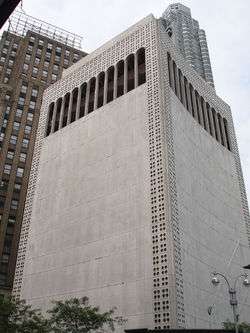
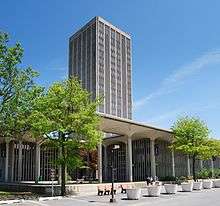

- Radio City Music Hall and the Center Theater, in Rockefeller Center, New York City, (as senior designer in the employ of the Rockefeller Center Associated Architects with Donald Deskey and Eugene Schoen, interior designers, 1932)
- Richard H. Mandel House, Bedford Hills, New York (with Donald Deskey, interior designer, 1933)
- Mepkin Plantation for Mr. and Mrs. Henry R. Luce, (now known as Mepkin Abbey), Monck's Corner, South Carolina (1936)
- Museum of Modern Art, New York City, (with Philip L. Goodwin, 1937)
- A. Conger Goodyear House, Old Westbury, New York (1938)
- Ingersoll Steel, Utility Unit House, Kalamazoo, Michigan (1946)
- El Panama Hotel, Panama City, Panama (1946)
- Fine Arts Center, University of Arkansas, Fayetteville, Arkansas (1948)
- United States Embassy, New Delhi, India (1954)
- Phoenicia InterContinental Hotel, Beirut, Lebanon (1954, altered 1997)
- Stanford Medical Center, Palo Alto, California (1955)
- Bruno & Josephine Graf Residence, Dallas, Texas (1956)
- Main Library and Mitchell Park Branch Library, Palo Alto, California (1956, Mitchell Park Branch demolished 2010)
- Edward Durell Stone Townhouse, 130 East 64th Street, New York City (1956)
- Stuart Pharmaceutical Co., Pasadena, California (1956, partially demolished)
- U.S. Pavilion at Expo 58, Brussels, Belgium (1957, partially demolished)
- First Unitarian Society Church, Schenectady, New York (1958)
- Gallery of Modern Art, including the Huntington Hartford Collection (now known as Museum of Arts & Design), New York City (1958, substantially altered 2006)
- International Trade Mart (now known as World Trade Center of New Orleans), New Orleans, Louisiana (1959)
- Robert M. Hughes Memorial Library, Norfolk, Virginia (1959, substantially altered 2011)
- Harvey Mudd College, Claremont, California (1959)
- North Carolina State Legislative Building, Raleigh, North Carolina (1960)
- Beckman Auditorium, California Institute of Technology, Pasadena, California (1960)
- National Geographic Society Museum, Washington, D.C. (1961)
- Museo de Arte, Ponce, Puerto Rico (1961)
- Windham College (now known as Landmark College), Putney, Vermont (1961)
- State University of New York at Albany, Albany, New York (1962)
- John F. Kennedy Center for the Performing Arts, Washington, D.C. (1962)
- Prince George's Center (now known as University Town Center), Hyattsville, Maryland (1962)
- Busch Memorial Stadium, St. Louis, Missouri (1962, demolished 2005)
- WAPDA House, Lahore, Pakistan (1962)
- Stuhr Museum of the Prairie Pioneer, Grand Island, Nebraska (1963)
- Claremont School of Theology, Claremont, California (1963)
- P.S. 199 School, Lincoln Square/Upper West Side, New York (1963)
- Davenport Public Library, Davenport, Iowa (1964)
- General Motors Building, New York City (1964)
- Ethel Percy Andrus Gerontology Center, University of Southern California, Los Angeles, California (1964)
- Tulsa Convention Center, Tulsa, Oklahoma (1964, expanded and renamed to Cox Business Center)
- Von KleinSmid Center, University of Southern California, Los Angeles, California (1964)
- Garden State Arts Center (now known as PNC Bank Arts Center), Holmdel, New Jersey (1965)
- Pakistan Institute of Nuclear Science and Technology, (1965)
- Georgetown University Law Center Bernard P. McDonough Hall, Washington, D.C. (1966)
- W.E.B. Du Bois Library, University of Massachusetts Amherst, Amherst, Massachusetts (1966)
- Brith Emeth Temple, Pepper Pike, Ohio (1967)
- Fort Worth City Hall, Fort Worth, Texas (1967)
- Kirwan-Blanding Complex, University of Kentucky, Lexington, Kentucky (1967)
- PepsiCo World Headquarters Complex, Purchase, New York (1967)
- Jefferson County Civic Center, Pine Bluff, Arkansas (1968)
- Worcester Science Museum (now known as the EcoTarium), Worcester, Massachusetts, (1964, altered 1998)
- Eisenhower Medical Center, Rancho Mirage, California (1971)
- Amarillo Museum of Art, Amarillo, Texas (1972)
- Standard Oil Building (now known as Aon Center), Chicago, Illinois (1972)
- Buffalo News Building, Buffalo, New York (1973)
- Scripps Green Hospital, La Jolla, California (1974)
- First Bank Building (now known as First Canadian Place), Toronto, Ontario (1975)
- Babin Kuk Resort, Dubrovnik, Croatia (1976)
- Florida State Capitol, Tallahassee, Florida (1977)
- University of Alabama School of Law, Tuscaloosa, Alabama (1977)
- Scripps Anderson Outpatient Pavilion, La Jolla, California (by Edward Durell Stone Associates, 1983)
- Government Center Station, Miami, Florida (1984)
- Scripps Research Institute, La Jolla, California (by Edward Durell Stone Associates, 1985)
- Museum of Anthropology, Xalapa, Veracruz, Mexico (by Edward Durell Stone Associates, 1986)
Gallery
 Radio City Music Hall
Radio City Music Hall
New York, New York
(1932) Anson Conger Goodyear House
Anson Conger Goodyear House
Old Westbury, New York
(1938)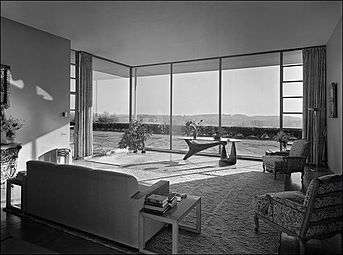 Anson Conger Goodyear House
Anson Conger Goodyear House
Old Westbury, New York
(1938)- Palo Alto Main Library
Palo Alto, California
(1956)  United States Pavilion
United States Pavilion
Expo 1958
Brussels, Belgium
(1957)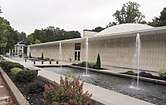 First Unitarian Society
First Unitarian Society
Schenectady, New York
(1958)
- National Geographic Society Headquarters
Washington, D.C.
(1961) 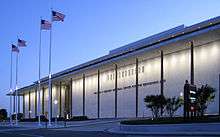 John F. Kennedy Center for the Performing Arts
John F. Kennedy Center for the Performing Arts
Washington, D.C.
(1962)

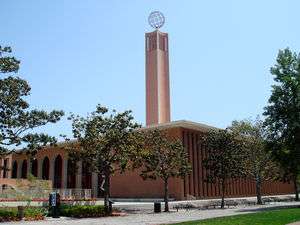
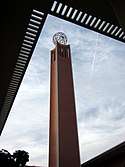
 PepsiCo Headquarters
PepsiCo Headquarters
Purchase, New York
(1967)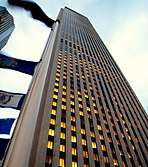
- First Canadian Place
Toronto, Ontario, Canada
(1975)
See also
References
Bibliography
- Everett, Derek R. "Modern Statehouses for Modern States: Edward Durell Stone's Capitol Architecture in North Carolina and Florida." Southern Historian, Vol. 28 (Spring 2007): pp. 74–91.
- Head, Jeffrey. "Unearthing Stone." Metropolis magazine, Urban Journal, January 2008.
- Hunting, Mary Anne. Edward Durell Stone: Modernism's Populist Architect (New York: W. W. Norton, 2013).
- Hunting, Mary Anne. "Edward Durell Stone, Perception and Criticism." (PhD diss., Graduate Center, City University of New York, 2007).
- Hunting, Mary Anne. "From Craft to Industry: Furniture designed by Edward Durell Stone for Senator Fulbright." The Magazine Antiques (May 2004): 110–121.
- Hunting, Mary Anne. “Legacy of Stone: As Campus Buildings Rise and Fall, A Leading Mid-20th-Century Architect’s Vision Endures,” Vanderbilt Magazine (Summer 2014): 18–19, 78–79.
- Hunting, Mary Anne. "The Richard H. Mandel House in Bedford Hills, New York." Living with Antiques.The Magazine Antiques (July 2001): 72–83.
- Hunting, Mary Anne. "Rediscovering the Work of Edward Durell Stone". Modern Magazine (Spring 2013): 70 and 72.
- Ricciotti, Dominic. "Edward Durell Stone and the International Style in America: Houses of the 1930s." American Art Journal, Vol. 20, No. 3 (Summer 1988): pp. 48–73.
- Ricciotti, Dominic. "The 1939 Building of the Museum of Modern Art: The Goodwin-Stone Collaboration." American Art Journal, Vol. 17, No. 3 (Summer 1985): pp. 51–76.
- Stone, Edward Durell. Edward Durell Stone: Recent and Future Architecture. New York: Horizon Press, 1967.
- Stone, Edward Durell. The Evolution of An Architect. New York: Horizon Press, 1962.
- Stone, Hicks. Edward Durell Stone: A Son's Untold Story of a Legendary Architect. New York: Rizzoli International Publications, 2011.
- Williams, John G. The Curious and the Beautiful. Fayetteville: University of Arkansas Press, 1984.
Notes
- ↑ In his memoirs, Stone mentions seeing buildings by Willem Dudok, Robert Mallet-Stevens, Tony Garnier, Eric Mendelsohn, Peter Behrens, Auguste Perret, and Ludwig Mies van der Rohe. Stone, Edward Durell. The Evolution of an Architect. (New York: Horizon, 1962): 24.
- ↑ Perhaps the best example is the Community Hospital of the Monterey Peninsula (1962). See Canty, Donald. "An Elegant Exception in Hospital Design" Architectural Forum (October 1962):108-111.
- ↑ "It's news when Wright lauds an architect" Palo Alto Times (3 August 1955): 2.
- ↑ Jordy, William H. "The Formal Image: USA" Architectural Review (March 1960): 157-165; Whiffen, Marcus. American Architecture Since 1780. (Cambridge: MIT Press, 1992): 261-266.
- ↑ "More Than Modern" Time (31 March 1958): 56-64.
- ↑ Atcheson, Richard. "Edward Durell Stone: Maker of Monuments" Show (March 1964): 72.
- ↑ "100 Largest Architectural Firms in the U.S." Architectural Forum (April 1963): 110-112; "100 Largest Architectural Firms in the U.S." Architectural Forum (April 1964): 14-16; "Man with a billion on the drawing board" Business Week (8 October 1966):124-131.
- ↑ "Edward Stone as Teacher and Critic" Arkansas Alumnus (March 1958): 2.
- ↑ "Honors" Architectural Record (July 1955): 16.
- ↑ See for example Smith, G.E. Kidder "Books of The Times" New York Times (15 January 1963): 121; "Books" Architectural Forum (January 1963): 7;Christ-Janer, Albert "Building on the Wright Foundation" Saturday Review (2 February 1963): 36-38; Beelke, Ralph G. Art Education (March 1963): 25-26;Snibbe, Richard W. "Search for a Personal Style" P/A (July 163): 160, 168; and Green, Walton AIA Journal (November 1963): 73.
- ↑ "Glass Buildings Throw Stone" San Francisco News Call Bulletin (25 July 1962): 19.
- ↑ See for example "Edward Durell Stone" The New Yorker (6 January 1968): 92.
- ↑ See for example Burns, James T. and Lapidus, Alan H. "Edward Durell Stone? Who Ever Heard of a Book Called Edward Durell Stone?" P/A (April 1968): 222,226; Gebhard, David. "Architecture" Library Journal (1 June 1968): 2231.
- ↑ See for example Hughes, Robert "The New Monuments" Time (13 September 1917): 68; Huxtable, Ada Louise "Architecture: A Look At the Kennedy Center" New York Times (7 September 1971):1, 46; Von Eckardt, Wolf "Kennedy Center: The Monument That Isn't" Washington Post (26 December 1970): B1-2.
- ↑ See for example Segrest, Robert. "Edward Durell Stone" Contemporary Architects. (New York: St. Martin's Press, 1980): 780.
- ↑ Pietro Belluschi to the AIA Jury of Fellows (27 November 1957).
External links
| Wikimedia Commons has media related to Edward Durell Stone. |
- The Edward Durell Stone web site, a resource for current information on the life and work of Edward Durell Stone
- Finding Aid for the Edward Durell Stone Papers at The University of Arkansas, David W. Mullins Library, Department of Special Collections
- Finding Aid for the James Hicks Stone Papers at The University of Arkansas, David W. Mullins Library, Department of Special Collections
- The Edward Durell Stone entry in The Encyclopedia of Arkansas History & Culture by Robert L. Skolmen
- An Edward Durell Stone biography established and maintained by the State University of New York at Albany
- Photographs of the Bruno and Josephine Graf house in Dallas, Texas
Two views on 2 Columbus Circle